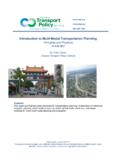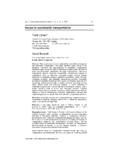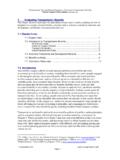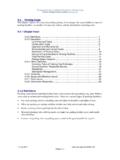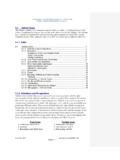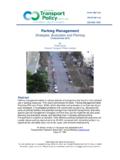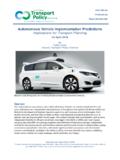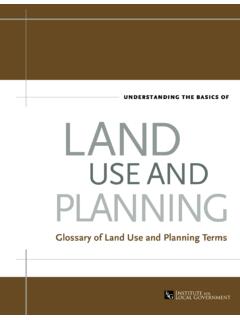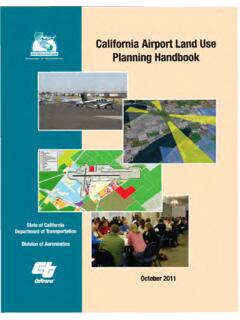Transcription of 2. Transportation Cost Literature Review
1 Transportation Cost and Benefit Analysis II Literature Review Victoria Transport Policy Institute ( ) 20 March 2020 Page 2-1 2. Transportation Cost Literature Review This chapter summarizes previous transport cost studies, including several that focus on freight costs. Index 2. Transportation Cost Literature Review .. 1 Introduction .. 1 General Cost Studies .. 3 Freight Cost Studies .. 19 Information Resources .. 23 Introduction Several previous studies have investigated various types of Transportation costs. This chapter summarizes some of them. Different types of studies have different purposes, which affects their perspective, methodologies and scope. For example, most highway cost allocation and investment evaluation studies are primarily concerned with direct market costs, such as road construction and maintenance, travel time, vehicle operating costs, and crash damages, and how these vary depending on vehicle type and roadway conditions.
2 They assumed that the total amount of vehicle travel does not change and so were unconcerned with vehicle ownership and parking costs. Other types of studies incorporate environmental impacts, primarily air pollution, but sometimes also noise and water pollution, and various categories of land use impacts. Some studies only consider tax subsidies or external costs (Delucchi and Murhpy 2008). Their results differ significantly due to differences in methodology and scope (for discussion see Quinet 2004). The following factors should be considered when comparing cost studies: The purpose of the analysis, and therefore its perspective, such as whether it considers only short-run marginal costs, long-run costs, and or total social costs. Categories of impacts considered, including vehicle costs, travel time costs, roadway costs, traffic services, parking costs, congestion impacts on other road users, delays to nonmotorized travelers, accident costs, pollution emissions and other environmental impacts.
3 Data sources and methodologies used to calculate costs, particularly non-market costs such as the costs of accident injuries and deaths, and environmental damages. How possible double-counting is addressed, such as whether taxes are counted as costs or economic transfers, and whether congestion costs are summed with travel time costs. Geographic scope and time period evalauted, and the inflation indecies and exchange rates used to convert values to a common monetaory 1 Unless otherwise noted, in this document other currencies are converted in the base year to US dollars and then adjustments for inflation are done by consumer price index (CPI). The source for both currency conversion factors and CPI adjustment factors is Samuel H. Williamson (2008) MeasuringWorth For a discussion of the significant variation possible using different methods see Lawrence H.
4 Officer and Samuel H. Williamson (2007), Measures of Worth. 2007; at Transportation Cost and Benefit Analysis II Literature Review Victoria Transport Policy Institute ( ) 20 March 2020 Page 2-2 Driving conditions, such as whether the costs represent urban-peak, total urban, rural or overall average driving conditions. Differences in measurement units, such as between miles and kilometers, and between vehicle miles and passenger miles. The types of vehicles considered, such as whether cost estimates are for cars, automobiles, the fleet of personal vehicles, total roadway vehicles (including freight vehicles) or total motor vehicles (including train, air and marine vehicles). Whether cost estimates are point values or ranges. Transportation Cost and Benefit Analysis II Literature Review Victoria Transport Policy Institute ( ) 20 March 2020 Page 2-3 General Cost Studies Cost Estimates Summary Table The table below identifies which costs are described or estimated in each report.
5 Table Transport Costs in Current Literature (D = Described; Q = Quantified/Monetized) Study No. 1 2 3 4 5 6 7 8 9 10 11 12 13 14 15 16 17 18 19 20 21 22 23 24 25 26 27 28 29 30 31 32 35 36 37 38 39 40 41 42 Cost Categories Keeler 1975 Hanson 1992 Mac Kenzie 1992 K geson 1993 KPMG 1993 Works 1993 Miller & Moffet 1993 Apogee, CLF 1994 US DOT, FRA 1993 CEC 1994 EPA, Aust. 1994 OTA 1994 Poorman CDTC 1995 Lee 1995 IBI 1995 Black et al. 1996 Maddison et al. 1996 IIEC 1997 Delucchi 1996 FHWA 1997 & 2000 DS & JF (TRB) 1997 Elwanger 2000 INFRAS 2000 / 2004 Sansom, et al 2001 Quinet 2004 NZMOT 2005 Tran. Canada 2003 / 05 CE 2004 Auckland 2006 Maibach et al. EC 2008 land Trans. NZ 2006 Clark and Prentice 2009 Smith, Veryard & Kilvington COWI, 2009 Becker, Becker & Gerlach 2012 Ricardo-AEA, 2014 Sen, Tiwari and Vrajaindra Upadhyay Santos, et al. 2010 ATAP, 2018 G ssling, et al.
6 2018 Vehicle Costs Q D Q Q Q Q Q Q Q Q Q Q Q Q Q Q Q Q Q Q Q Q Travel Time Q D Q Q Q Q Q Q Q Q Q Q Q Q Accidents Q D Q Q Q Q Q D Q Q Q Q Q Q Q Q Q Q Q Q Q Q Q Q Q Q Q Q Q Q D Q Q Q Q Q D Q Q Parking Q D Q Q Q Q Q Q Q Q Q Q Q Q Q Q Q D Q Q Congestion Q D Q D Q Q Q D Q Q Q Q Q D Q Q Q Q Q Q Q Q Q Q Q Q Q Q D Q Q Q Q D Q Q Facilities Q D Q Q Q Q Q Q Q Q Q Q Q Q Q Q Q Q Q Q Q Q Q Q D Q D Q Roadway land Q D D Q D Q Q Q Q D Q Q Q Q Q Q Mun. Services Q D Q D Q Q Q Q Q Q Q Q D Q Q Q Q Q Q D D Q Q Local Air Pollution Q D Q Q Q D Q Q D Q Q Q Q Q Q Q Q Q Q Q Q Q Q Q Q Q Q Q Q Q Q D Q Q Q Q D Q Q Global Air Pollution D Q Q D Q Q D Q Q Q Q D Q Q Q Q Q Q Q Q Q Q Q Q Q D Q Q Q Q D Q Q Noise &Vibration Q D Q Q Q D Q Q D Q Q Q Q D Q Q Q Q Q Q Q Q Q Q Q Q Q Q Q D Q Q Q Q Q Resources/Energy D Q Q D Q Q D Q Q Q Q D D Q Q Q Q Q D Q Q D Q Barrier Effect D D D Q D D D D land Use/Sprawl D Q D D D Q D D D Q Q Q D Q D Q Q Q Inequity D Q D D D Water D D Q D Q Q D Q Q Q Q D D Q Q Q D Waste Disposal D Q Q Q D D Q Q Activity Benefits Q D Q Q Q This table indicates which costs are described (D)
7 Or quantified (Q) in the various studies summarized Cost and Benefit Analysis II Literature Review Victoria Transport Policy Institute ( ) 20 March 2020 Page 2-4 Studies This section describes specific Transportation cost studies. 1. Keeler, et al (1975), The Full Costs of Urban Transport; Intermodal Comparisons, Institute of Urban and Regional Development (Berkeley). This report compares commuting costs of automobile, bus and rail in the San Francisco Bay area. It includes marginal congestion costs, public services, noise, air pollution, facilities, accidents, parking, and user costs. This is the oldest study of its type. The analysis is still highly regarded. 2. Mark Hanson (1992), Results of Literature Survey and Summary of Findings: The Nature and Magnitude of Social Costs of Urban Roadway Use, Federal Highway Administration. This report identifies external costs of urban roadway transport and describes costing methods.
8 It also includes recommendations for better calculating external costs, incorporating costs into user prices, and applying least-cost planning to Transportation . 3. James MacKenzie, Roger Dower, and Donald Chen (1992), The Going Rate, World Resources Institute (Washington DC; ); at This is a comprehensive study of motor vehicle costs. Cost categories include roadway facilities and services, parking, air pollution, oil import costs, congestion, traffic accidents, noise, and land loss. Concludes that driving incurs $300 billion annually in external costs. 4. Per K geson (1993), Getting the Prices Right; A European Scheme for Making Transport Pay its True Costs, European Federation for Transport and Environment ( ) This study estimates pollution, crash and infrastructure costs in European countries. Cost summaries for the UK are shown in Table 2-1. Similar estimates are made for other countries.
9 Table External Transport Costs (ECU/1000 passenger km) Mode Air Pollution CO2 Noise Accidents Total Total ($/mile) Car $ Electric train $ Aircraft $ 5. KPMG (1993), The Cost of Transporting People in the British Columbia Lower Mainland, Transport 2021/Greater Vancouver Regional District ( ). This study develops cost estimates for 12 modes using local research and generic estimates. Costs are listed in Table Table Costs of Transporting People in Costs Direct User Indirect Parking Transport Infrastructure Time Urban Sprawl Environmental and Social Fixed vehicle costs Variable vehicle costs Parking fees Residential Commercial Government Road construction Road maintenance Road land value Transit land value Protection services Personal Commercial delays Infrastructure Loss of open space Future transport Unaccounted accident costs Air pollution Noise pollution Water pollution Transportation Cost and Benefit Analysis II Literature Review Victoria Transport Policy Institute ( ) 20 March 2020 Page 2-5 6.
10 Works Consultancy (1993), land Transport Externalities, Transit New Zealand (Wellington). This comprehensive study is part of New Zealand s efforts to rationalize transport planning. It attempts to describe all external costs of road transport, and identify costing methodologies. Cost categories are shown in Table Table Works Consultancy Cost Categories Pollution Effects Intrusion Effects Interference Effects land Use Air Pollution & Dust Impacts on the Global Atmosphere Effects on Water Systems Noise & Vibration Disposal of Waste Visual Effects Habitat impacts Effects on Landscape Archaeological Sites Cultural & Spiritual Effects Recreational Effects Strategic Effects Community Disruption Urban and Rural Blight and Stress of Change Lighting Effects Community Severance and Accessibility Hazard Effects 7. Peter Miller and John Moffet (1993), The Price of Mobility, Natural Resources Defense Council ( ).
